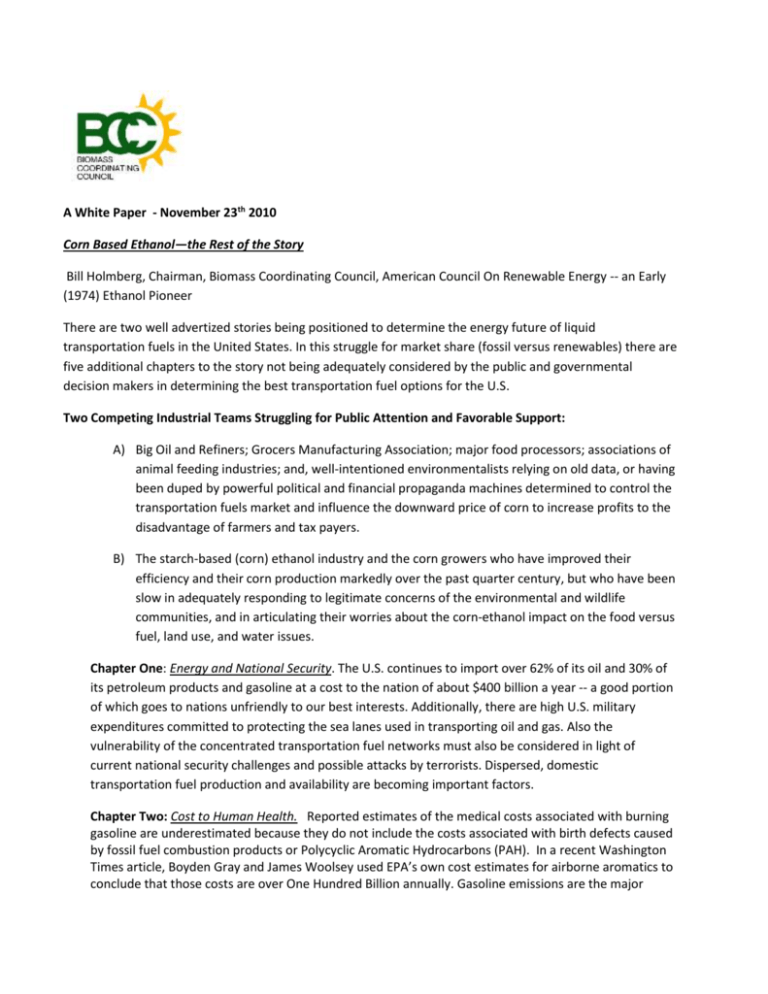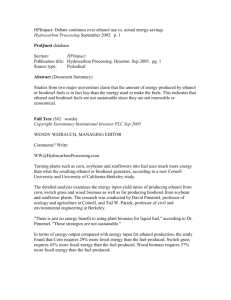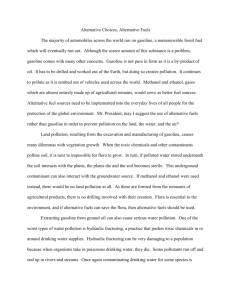A-White-Paper2211 - American Council On Renewable Energy
advertisement

A White Paper - November 23th 2010 Corn Based Ethanol—the Rest of the Story Bill Holmberg, Chairman, Biomass Coordinating Council, American Council On Renewable Energy -- an Early (1974) Ethanol Pioneer There are two well advertized stories being positioned to determine the energy future of liquid transportation fuels in the United States. In this struggle for market share (fossil versus renewables) there are five additional chapters to the story not being adequately considered by the public and governmental decision makers in determining the best transportation fuel options for the U.S. Two Competing Industrial Teams Struggling for Public Attention and Favorable Support: A) Big Oil and Refiners; Grocers Manufacturing Association; major food processors; associations of animal feeding industries; and, well-intentioned environmentalists relying on old data, or having been duped by powerful political and financial propaganda machines determined to control the transportation fuels market and influence the downward price of corn to increase profits to the disadvantage of farmers and tax payers. B) The starch-based (corn) ethanol industry and the corn growers who have improved their efficiency and their corn production markedly over the past quarter century, but who have been slow in adequately responding to legitimate concerns of the environmental and wildlife communities, and in articulating their worries about the corn-ethanol impact on the food versus fuel, land use, and water issues. Chapter One: Energy and National Security. The U.S. continues to import over 62% of its oil and 30% of its petroleum products and gasoline at a cost to the nation of about $400 billion a year -- a good portion of which goes to nations unfriendly to our best interests. Additionally, there are high U.S. military expenditures committed to protecting the sea lanes used in transporting oil and gas. Also the vulnerability of the concentrated transportation fuel networks must also be considered in light of current national security challenges and possible attacks by terrorists. Dispersed, domestic transportation fuel production and availability are becoming important factors. Chapter Two: Cost to Human Health. Reported estimates of the medical costs associated with burning gasoline are underestimated because they do not include the costs associated with birth defects caused by fossil fuel combustion products or Polycyclic Aromatic Hydrocarbons (PAH). In a recent Washington Times article, Boyden Gray and James Woolsey used EPA’s own cost estimates for airborne aromatics to conclude that those costs are over One Hundred Billion annually. Gasoline emissions are the major source of toxics our children and their parents are exposed to daily. Yet, the EPA does not recognize gasoline’s mutagenic properties and associated birth defects in any assessment of the medical costs associated with gasoline emissions. The EPA concludes enforcing the clean air act’s restrictions on aromatics would cost too much. But short chain hydrocarbons like ethanol simply do not contain or produce aromatics on combustion, and provide the needed octane in gasoline at no added costs to the consumer. Gasoline’s PAHs are identical to the PAHs, the primary toxics found in cigarette smoke. The mutagenic properties of these PAHs are known, and numerous studies readily recognize the birth defects associated with second hand smoke. Recent UCLA research, “Air Pollution’s Impacts on Infants and Children,” addresses birth defects associated with even low density traffic. The study concludes traffic pollution leads to up to a 30% increase in preterm births and a similar increase with infant mortality and, "Certain vulnerable population segments -- the poorest and most exposed -- may experience much higher risks." The most logical and cost effective way to reduce the medical costs associated with gasoline emissions is for the EPA to withdraw its exemption for mobile source fossil fuel aromatic emissions (benzene, toluene, xylene), making way for cleaner-burning additives and fuels. Chapter Three: Science and Technology delays and advances. In 1939, the U.S. established a USDA laboratory in Peoria, IL dedicated, in part, to the production of ethanol from cellulosic biomass. Seventy years later, commercialization is still elusive. A recent study from the Department of Agriculture raised concerns about the economics of biofuels from plant cellulose and suggested that federal funds be poured into algae and oil crops. "After two decades of research without a sustainable technical breakthrough to make cellulosic ethanol competitive, it appears that it is time to re-evaluate the research," the report noted. In the world of biomass, the easiest way of converting sunlight into usable energy is: first through sugars, then starches, starch/proteins, hemicellulose/cellulose, and then lignin. The starch/protein team (corn and milo), could reach 15 billion gallons by 2013, providing hundreds of thousands of jobs and generating tens of billions of dollars in taxes, savings and business operations per year to the benefit the public. On Election Day 2012, we will likely still be importing over 60% of our transportation fuels while the hemicellulose/cellulose/algae industries will hopefully be on their way producing about 1/2 billion gallons of fuel (about 3% of the corn-based capacity) with comparatively limited job opportunities. It will be some time in the future before these promising industries overtake the sugar/starch/protein team as this team continues to increase efficiency and expand their feedstock base to include sugar cane, sweet potatoes, sunspuds, sweet sorghum, small grains like barley, and sugar bearing grasses. Perhaps 2020 would be a possibility. In the meantime, the sugar/starch/protein team will do the heavy lifting for America – and this includes turning concerns about the buildup of greenhouse gases into profitable businesses by recognizing that biomass, soils and the oceans (also involving biomass) are the biggest carbon sinks in the world. Chapter Four: Advances in Technology. Advances in science and technologies are providing lighter, more efficient and powerful engines benefiting from the clean burning, high octane, and the single molecule characteristic of ethanol. These benefits are not found in gasoline or in some of the advanced “drop in” fuels. Continuing advances in science and technologies used to produce sugar/starch/starch protein and vegetable oils into ethanol and biodiesel, also lend themselves to profitable smaller-scale biorefineries suitable for “family farmers” and rural communities. Properly managed, with nationbuilding/community-building incentives, these enterprises will bring families and younger life back to farming and forestry businesses to the betterment of the people, the environment and the planet. They will also add, through dispersed systems, more to our energy and national security while creating meaningful jobs. With advanced science and technologies in satellites, GPS systems, and computers; and scientists trained in soils, water, wildlife, microbes, statistics and modeling, it will soon be possible to remotely determine, reinforced by on-site measurements, natural conditions on a pixel bases (30 meters by 30 meters square). This capability will provide the potential of ensuring that each pixel of land is maintained at its optimum, sustainable productivity level to include: biomass growth, water conservation, soil vitality, productive fish and wildlife habitat (cover, water, food), and positive greenhouse gas measures (reductions in CO2, methane and N2O). This capability, already commercially operational on a limited bases, will continue to evolve over time as the technology and resources become available. This will not only ensure broad-based optimum productivity and sustainability on farms and forests/woodlots, but will also create thousands of quality jobs for people as caretakers of our lands while producing sustainable biomass feedstocks for food, feed, fiber, fuel, fertilizers and chemical feedstocks. Greatly underestimated, chemical feedstocks from biomass are producing a widening range of products -- anything not made from minerals or metals can be made from biomass; from solvents and pharmaceuticals to auto parts. In short, the food versus fuel and indirect land use concerns will be well managed to the benefit of humans, animals and natural systems. Using these scientific and technological advances, and the creativity and determination of the American people, biomass will continue to play a major role in meeting national needs in the food, feed, fiber, fuel, fertilizers and chemical feedstocks fields while ensuring sustainability; and lead to enhancements in farm and forest lands, watersheds, wetlands, riparian buffers, wildlife habitat, vitalized soils, water supplies, and profit-making greenhouse gas reductions. Importantly, this will contribute to the reindustrialization of America and the creation of “Sustainable New Wealth” industries with major economic multipliers, generate millions of jobs, help revitalize our economy, and, pay down our national and international debts. [NOTE: Chapter Five: The Summation, follows the Options section.] OPTIONS IN MOVING FORWARD: First Option: The two Teams can compete in the transportation sector, “no holds barred,” by organizing their political and financial prowess to gain sought-after advantages over competitors. These are expensive, disruptive and distracting activities at a critical time in American history. We cannot afford this fight. Second Option: Or, we can do the right thing by the American people and the planet by bringing honesty and integrity to a competitive marketplace where externalities outlined above are included in the calculus and used in determining incentives and other benefits. While this transition is occurring, both sides can make money with the following plan. Considerations worthy of immediate actions include: Encourage public support for the wise and environmentally sound exploration and use of cleaner burning domestic fossil fuels to reduce imports and “energize” our economy (quantifying the externalities). The fossil transportation system already has in place the distribution and fuel utilization technologies that have favored gasoline and diesel for almost a century. While corn-based ethanol initiated and advanced the development of the biofuels distribution infrastructure; the overall transportation fuels distribution systems remain fossil fuel oriented. Better collaboration will be of real service to the nation. Call for the accelerated production of more efficient flexible fuel vehicles with engine characteristics that take advantage of a variety of fuels, including biofuels. EPA authorizing more extensive use of higher blends levels of ethanol in gasoline to expand the market for ethanol and reduce imports of oil and gasoline. EPA, reducing aromatics in gasoline by authorizing higher ethanol blend levels, not only effectively addresses the air toxics issue, but also leads to the production of more gasoline per barrel Greatly increase the availability of alternative fuel/charging stations to accommodate gasoline, diesel, biofuels, natural gas/biogas, electricity and hydrogen The VEETC Plan: o Reduce the VEETC and maintain a reduced import tariff for one year. o Adjust the VEETC for additional 4 years to: o Convert the blender credit to a reduced producer credit, Provide funding for infrastructure development, and Provide incentives for increased efficiencies in feedstock production conversion efficiencies. PAYGO: Reallocate funds dedicated to the SPR expansion to pay for this biofuel capacity increase as a “virtual” transportation fuel reserve. The Last Chapter - Chapter Five: New Wealth Industries. The information and proposals outlined above will help ensure the advance of the U.S. economy through reindustralization, generation of “New Wealth,” major job creation, and the ability to pay down our national and international debts. Generally, “New Wealth” is only created when nature is debited for providing natural resources, but does not demand payment. The resulting monetary value creates “New Wealth,” with major economic multipliers. This New Wealth is provided by the extractive industries –coal, oil, gas, minerals, metals, etc. New Wealth is also provided by the sustainable industries – agriculture, forestry, hunting, fishing, all the renewable energy technologies (solar, wind, biomass, hydro, water power, geothermal and renewable hydrogen), energy efficiency, recycle, reuse, and Human Creativity (critically important and depends on quality education). Advanced science and technology, team work, and a commitment to sustainable future will not only restore economic and environmental health to America, but also ensure our leadership in a future that must be sustainable – a world where the best in science and technology, human creativity, integrity, hard work, and compassion, are combined with the lasting power and creativity of natural systems – advancing together in common cause. The days of exploiting natural systems without lasting care are coming to an end. The five chapters outlined above offer additional pathways to a sustainable future, while all sides make a good return on their investments. This is sustainability with prosperity.







